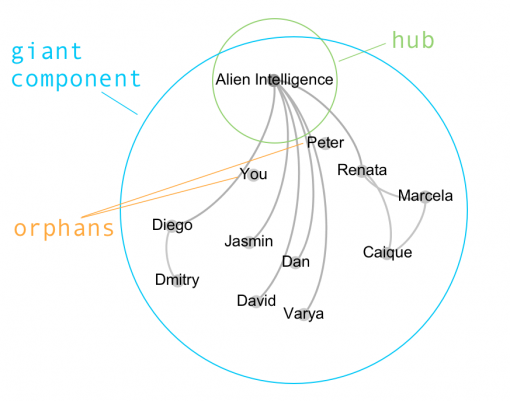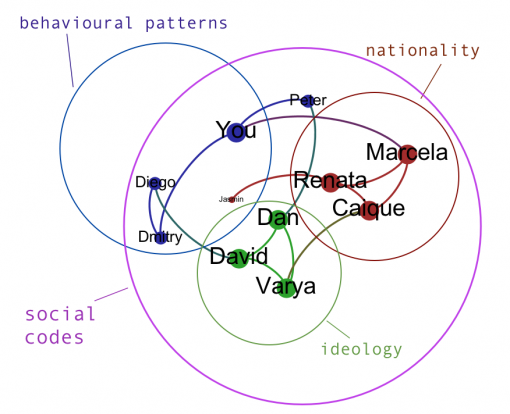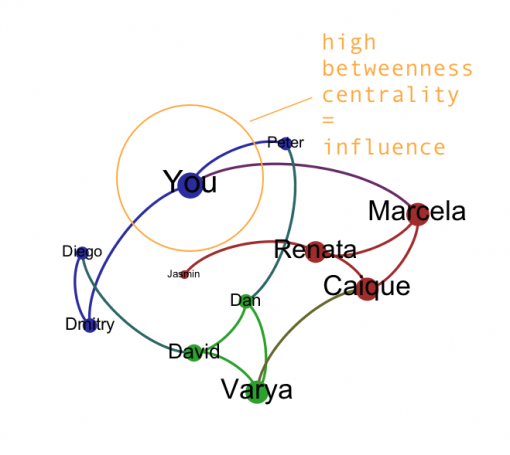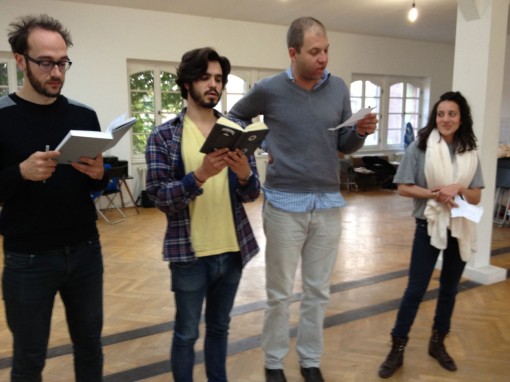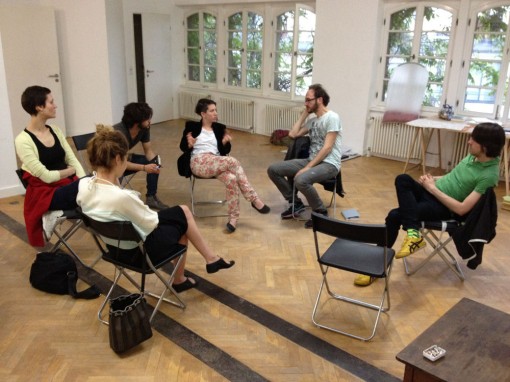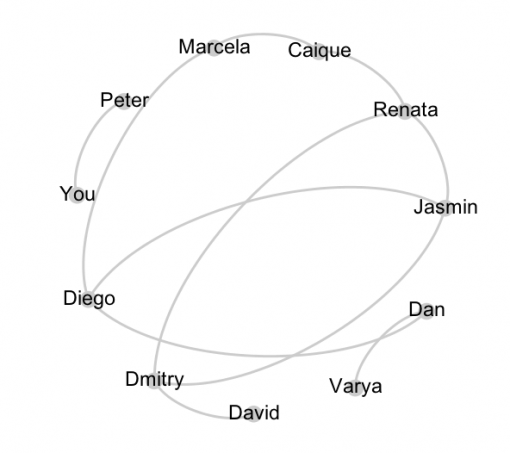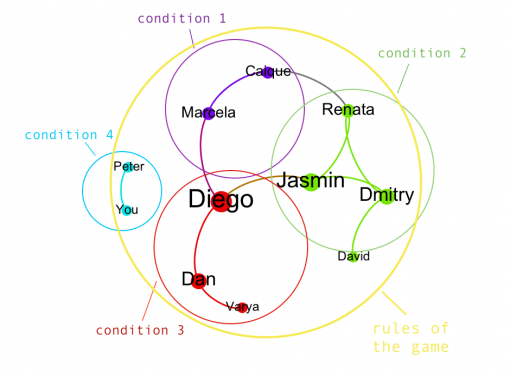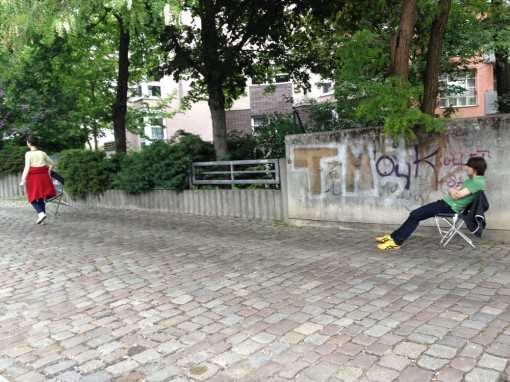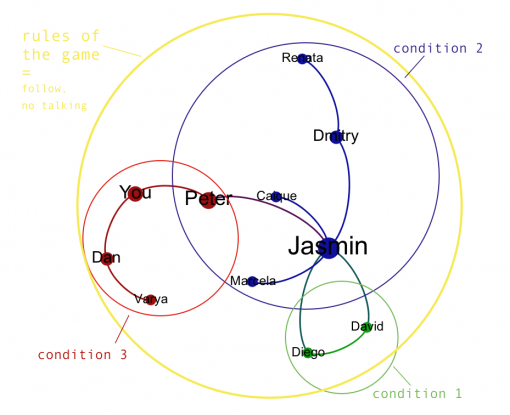Posted by Nodus Labs | May 31, 2012
Embodying Social Networks Workshop
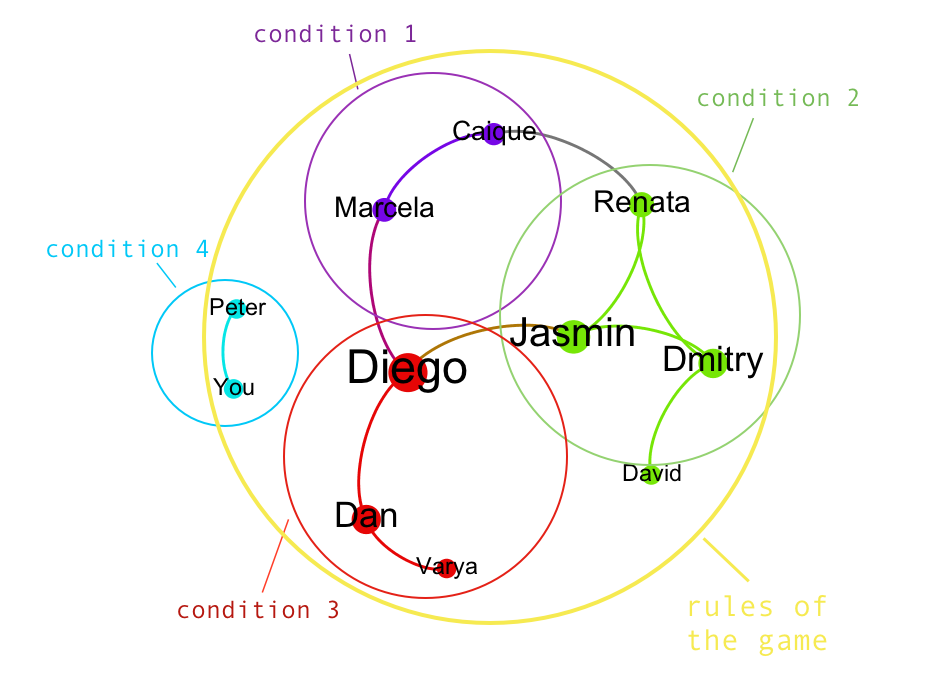
Networks are everywhere and yet it’s still a very abstract concept. Together with our colleagues from Transnomia Institute we put together a special workshop that offers a very tangible experience of networks to the participants. As a result, they get intuitive and embodied knowledge of various network structures and learn to extend their social skills beyond the common patterns and codes of behavior.
Project: “On Discord” workshop at Agora Collective
Objective: Inform the participants about the basic concepts used in network analysis followed by a performative situation designed to help the participants embody these concepts and incorporate them into their behavior.
Network is a very useful framework for thinking about community. The people can be represented as the nodes, and their interactions as the connections between them [1]. Once we start thinking about any community as a network, we can use various tools from graph theory to explore the groups that the community is made of, to find the most influential members, to expose the dynamic social processes that shape the structure of the community. Most of the time, however, very abstract models are used to demonstrate the applications of network analysis to the social context. At very best we can visualize someone’s Facebook network, but the insights that we get from it cannot be tested here and now. That’s why we developed a set of exercises that can be performed in real social situations in order to bring the ideas from network analysis into our everyday interactions.
We would like to introduce some basics first.
Stage 1: Introducing the Basic Concepts
During this phase we introduce the basic concepts from network theory using the group of participants as a model. Let’s assume that 11 people are present inside a room and only a few of them know each other. This is how their network would look like (each participant would draw their own network as an exercise):
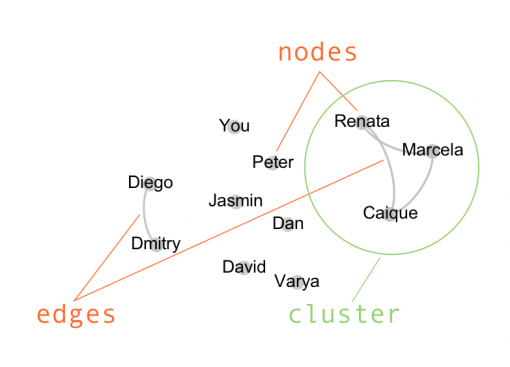
The nodes are the people, the edges represent the connections between them (friendship, frequency of interactions during the last month, sharing a certain belief, etc). When the nodes are unified in a small subgraph, we call it a cluster.
Now it’s quite clear that such social structure would not be very efficient in spreading information among all members or unifying for a collective action. Most people don’t know each other, there are no links between them, so there’s no informational pathways for communication within the group.
The situation changes drastically when we introduce a hub – the node that is connected to most (or all) other nodes in the network. Now most of the nodes belong to the same graph, which is called giant component (because it contains most of the nodes in the network) – it’s possible to reach almost any node from any other node. The nodes that don’t belong to the giant component are called orphans (in the example below it’s you and Peter, who didn’t succumb to the Alien Intelligence).
The network above is modular (there are distinct communities or clusters present within), heterogenous (some nodes have many connections, some only have a few or none), and highly organized (even hierarchical in this case). [2] Obviously, there’s a lot of pressure on the main hub, the Alien Intelligence, to spread information through this network. If we would like this network to be a bit more self-organized, we’d rather build links between the existing members, to allow them spread information to one another without consistent external stimulation. Remember, we need to ensure there’s still giant component within the network, so the most efficient way to create it would be to link the two existing clusters together (Diego-Dmitry and Renata-Marcela-Caique), then unify all the “orphans” (e.g. You-Peter and Dan-David-Varya), join these new clusters together and then link them to the other two clusters. The resulting image would look something like this:
We can now see that all the clusters are connected to one another and such network can use its own infrastructure to proliferate information. It does not need any external impulses in order to communicate. Different color designates a different community – the nodes that are more densely connected to each other than to the rest of the network. The nodes that have more connections (a higher degree) are shown bigger on the graph. Each edge in this graph represents interaction. The fact that we show them all within the same graph implies that the underlying principles of this interaction are more or less the same (i.e. the social codes). At the same time, there may slight differences in how the members of the green cluster relate to one another if you compare it with the members of the red cluster. This alone may be sufficient reason for the nodes to split into groups. Therefore, it’s important to think of the edges as a kind of social glue that connects people together and to be aware about the essence of this glue. Each community comes together on the basis of sharing something in a unique way: ideology, beliefs, social codes, nationality, sex, common practice.
Another interesting measure is that of betweenness centrality, which shows the influence of a node in the network. Technically, this parameter shows how often a node appears on the shortest path between any two randomly chosen nodes in the network. In other words, if a node connects different communities together, which are themselves quite large in size, it will have a higher betweenness centrality. In the graph above, 7 out of 11 nodes have the same degree (the number of connections) that equals 3. However, the node “You” has the highest betweenness centrality and is the most influential one, because it connects the green community to the red one and it also has a short path (through Peter) to the red community.
Now that we went through all the main concepts of network analysis, we can move on to the practical implementation of this knowledge.
Stage 2: What is a Community?
Giorgio Agamben, a prominent Italian philosopher, is often quoted for coming up with the term “whatever community” [3], which is often used in the context of performing arts as a starting point for thinking about any sort of collectivity. The idea of “whatever community” is attractive, because it proposes the kind of being together that is devoid of any ideology or shared categories. It is instead based on a sort of dynamic proximity that is open to continuous change and doesn’t seek any unifying principles. However, such structure is very unstable, especially when it has to compete with the more concrete propositions that exist in the real world. “Whatever community” of artists would not be able to withstand the aggression of the right-wing tightly-knit fascistic group, which doesn’t accept any compromises. In the very best case, it would save its individual members by adopting amoeba-like state, but the principle of “whatever” does not stand a good chance in the world where concrete and tangible things are still quite prominent. In this way we relate more to the proposition expressed in The Coming Insurrection text published by the French activists Invisible Committee: “commune is the joy of encounter that survives its expected end” [4]. In order to survive its expected end the community has to have a certain commitment that extends beyond the commonly accepted norms of behavior. There has to be a certain level of “truth” in their encounter, the social glue that holds that particular group of people has to be strong enough to withstand the external distractions. In this context, Jean Luc Nancy’s statement “community of love is a community living to share the absence of common being” [5] provides a concrete example of what this truth can be based on. Famous theater director Peter Brook used to say “when you’re just about to stop, something interesting is going to happen”. The reason for that is very simple: the moment you want to stop sharing your time with someone, you maintain the context that you established with the group. If you go beyond that moment into the unknown, you create the new context, you extend the joy of encounter beyond the expected end, you share the absence of common being and you stil go on, because you want something to happen, you need an event (going beyond) that will bring you together in a much stronger and intense way.
In order to introduce these ideas into practice, we start with a simple exercise where everyone in the room walks freely around the space. We then find a common condition (first introduced by the leader, then by anyone in the room) and we all try to follow it. The common condition becomes the social glue we’ve talked about before. It can be a way of breathing (slow, fast, irregular), a sound (mmmmm….), a word (ok? ok…), even an intonation or a certain movement. The point is that everyone in the room shares the same movement proposed. Once we feel we went beyond the moment of expected end, we allow it to go on a little bit longer and then introduce another condition for everyone to share. We then split into groups and each group works on their distinct condition for a few minutes. Once every group is ready with their concrete state-proposition, we introduce a new rule: any person can leave their group and join a new one. Their goal is to adopt the condition of the group they joined. Once someone joins a group, a person from that group should leave to join another group. We then introduce a rule where the dynamics is the same, but the group should adopt the state proposed by the person who joined them. As the final stage of the exercise we propose that people can form groups like they want.
This simple experiment allows participants to experience the variety of conditions that can bring people together, expanding beyond the common social codes and norms of behavior. It heightens their social and physical sensitivity to each other and to their surrounding. These exercises are similar to those practised by Joseph Chaikin or Viola Spolin for theater actors, the difference is that we practise them using the framework of networks to enhance our intuition when interacting with others.
Stage 3: Introducing the Chair Game
The chair game is a simple way to experience networks in a way that’s not only conceptual, but also embodied. It is well known in cognitive science that the body participates in producing the meaning as much as the mind [6], so the best way to understand the dynamics of networks is to try it out in a real-life social situation.
The premises of the game is very simple. We erase the existing social codes and previous social connections in order to establish a new structure based on the simple rules that lead to self-organized patterns of behavior. The chair game is performed in 4 phases, each phase lasts 20 minutes.
Phase 1: Follow the person to your right for 20 minutes, Use a chair, No talking.
We ask the participants to form the groups based on who they already know well (this will produce a social constellation similar to that of the network image shown in the very first image above). We then ask them to shuffle between the groups, so that they end up standing next to somebody they don’t know so well. We then ask them to form a circle. The first phase of the game has the following rules:
– everyone uses a chair,
– everyone can move where they want, BUT they should always sit on the chair,
– everyone should always see the person to their right,
– no talking is allowed (in order to suspend the previous social network structure).
This simple rule produces a regular directed lattice graph, where the social glue is the simple rule of having the person to your right in the field of vision. It’s quite obvious that if one person decides to move, the rest should follow. However, in order for the whole group to move, the majority must decide that it’s necessary to do so. Otherwise, the backwards force will be too strong. Here’s the graph that represents this social constellation: it has a giant component, there are no subcommunities, and all members have equal number of connections (degree) and equal influence (betwenness centrality). They are free to experience a network that’s totally fair, both towards each other and towards the group as a whole.
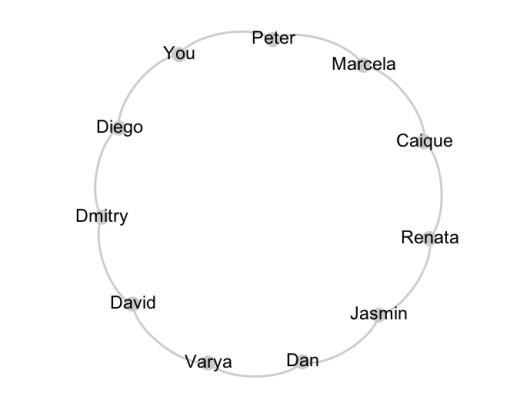
After we experiment with the first phase of the game for 20 minutes, we move on to the next stage.
Phase 2: Choose another person to follow for 20 minutes, Use a chair, No talking.
During the second stage the participants can choose themselves who they should have in their field of vision for the next 20 minutes. They should still use the chairs and no talking is allowed. Given that the social rules have been suspended, it is unlikely that people will choose to “follow” someone they know from before. Rather, it’s going to be somebody who they got curious about during the first stage. The resulting structure will look something like a regular graph with random shortcuts. Some groups might be disconnected from each other if the people inside choose to follow each other and “lock” themselves into a sort of feedback loop:
The participants are now invited to observe and experience what it means to belong to a group and what it means to have a different kind of betweenness within the network. Without a question, over the time, each group might establish its own “condition“, the unique “social glue” that will set it apart from the rest (like in the Stage 2 of the process). At the same time, everyone still follows the main rule of having one person in their field of view, so that overall rule structure replaces the temporarily suspended social codes of behavior.
Such constellation replicates everyday social structures, but there are still some limitations (the rules of the game), such are the necessity to use the chairs (making the structure less fluid) and inability to speak to one another (suspending the social rules of behavior).
Phase 3: Choose someone else to follow for 20 minutes, No chairs, No talking
At this third stage of the game, people are allowed to let go of the chairs, they can choose who they follow, but they are still not allowed to speak. As a result, the network will become more more fluid (the chair limitation is gone), but the fact that people still have to follow each other for 20 minutes and that they cannot speak doesn’t allow the situation to flow into something that’s more of an everyday encounter. Comparing to the graph above, the social structure will change and other constellations (communities) will form, producing the new centers of influence:
Phase 4: Change who you follow at least 3 times during the next 20 minutes, No chairs, No talking
The next phase is approaching closer to a real-life situation. We now can have anyone we want in our field of vision, but it should always be at least one person. This way we ensure that there are always communities formed (maybe even a giant component) and that there are no “orphans” left. The ability to change who you follow makes the network more dynamic, the constellations change and so does the influence and connectivity of the members within. The restriction on speech doesn’t let the situation become something of an everyday situation. People can gather in groups, but as they cannot talk the rule of always having at least one person in one’s field of vision makes it easy to switch the group or to experiment with physical constellations that are not standard for social environments.
Phase 5: Follow who you want, No chairs, Talking is allowed
At this stage we replicate a standard everyday social situation, but because the participants have been engaged in a very specific activity during the last 1.5 hours, they have a heightened awareness of the social constellations, conditions or states established within the group, network structures, individual influence. They are also allowed to suspend the rules of social behavior by deciding to switch the group they are engaged with at the moment by having to have someone else in their field of vision. Some skills from Stage 2 of the training may be required in order to be able to enter the new groups and for the groups to be more open to the conditions that they are proposed by the newcomers.
Phase 6: Integrate into a social context
As the final stage the participants are invited to enter a social context: e.g. a party, a bar, a gathering, and to use the strategies they’ve experienced during the last two hours in order to experiment with different forms of group behavior. The participants become the agents of polysingularity: they are able to maintain and link several centers of social activity at once and yet they are committed to each and every one of them.
Resources
[1]. A good introduction into the study of networks is Newman, M. E. J., Barabasi, A.-L., & Watts, D. J. (2006). The structure and dynamics of networks. Princeton University Press.
[2]. You can find more information on the types of network in our Types of Networks post.
[3]. Agamben, G. (1990). The Coming Community.
[4]. The Coming Insurrection (2004). http://en.wikipedia.org/wiki/The_Coming_Insurrection
[5]. Nancy, JL (2001). Love an Community. EGS
[6]. See Johnson (2008) “On the Meaning of the Body” and Chemero (2009) “Radical Embodied Cognitive Science”

